Imagine quoting for a job and losing out to the competition only to be called back a few months later by the same client who now wants you to make good the cock-ups of their chosen installer after things went bad. Well, there's a plot-twist to this one; see if you can guess it before the end!
Nobody likes a smartarse, so I won’t begin by saying ‘I told you so’, but... uh... in this case I did specifically state the following at the end of the quotation paperwork provided to the client:
“If you are securing pricing from other electricians, check the Registered Competent Persons database at http://www.electricalcompetentperson.co.uk/ to ensure they are accredited. Non-accredited installers will not show up on a search and may not be able to provide the Building Regulations certificate of compliance.”
I really do get sick of typing that sentence. It’s there on my quotation template, but it is frustrating the amount of emails I answer where I have to mention the existence of the Electrical Competent Persons database and why any homeowner should check it before letting loose someone who says they're a sparky on their home. In this case, the installer who has performed the electrical work is not accredited and does not appear on the database, yet despite my advice the client has proceeded to appoint them to undertake work which falls under Part-P of the Building Regulations.
The only way for this installer to have accepted this job and legally complied with the building regs is to tell the homeowner to first submit a planning application to Warwick District Council before they started on site as the homeowner is responsible for submitting planning paperwork if the installer cannot self-certify their own work. Of course, that never happened, so now the homeowner lacks the paperwork which should have gone with the job. That’s a problem because it leaves them legally liable for the alterations which can invalidate their insurance, it can cause a headache when renting or selling the property (they do rent a room to a student lodger), or it can leave them in hot water if Local Authority Building Control come a-calling, because it is now their responsibility to prove the work was undertaken correctly and they cannot do so without appointing an approved third party to perform an Electrical Installation Condition Report on the whole of the electrical installation at additional expense.
Lack of accreditation also means there’s no Competent Persons Scheme to file a complaint with. If the installer had been accredited with a CPS, then escalating a complaint would have seen the installer leant on to cough up outstanding paperwork and (in theory) make good any valid complaints the client had about the work or the invoicing.
In this case, I have known these clients for years and have done prior work for them on several occasions which they had been happy with, so when asked to provide pricing for their new kitchen back in January I gave them a written scope of works detailing what I would do and how much it would cost, priced as favourably as possible as always.
I didn’t hear back, and I was too busy to chase, so I assumed the project had either stalled or they had used someone else. It turns out to have been the latter, as at the beginning of August I was contacted by the clients and told the chosen electricians had apparently "botched the job" and disappeared leaving things unfinished. They wanted me to come around to assess the work and put right the damage.
What I should have done, and what I will only do from now on in such cases for reasons to be explained later, is to have offered to perform a paid electrical inspection of the work with the aim of producing a report detailing the explicit faults. Instead, I offered to undertake the remedial work and write a report as I went along, much of which is contained as part of this article, so that the clients could speak with Trading Standards, the small claims court or a private action of whatever kind against their installer in an attempt to get some of their money back. Of course, I would be charging for my time and any supplied materials in my documenting all that had been made good along the way. The advantage to the clients of doing it this way would be that the stuff which was bad, unsafe or not working would be put right sooner rather than remaining dangerous or non-functional while any arguments or legal action dragged on.
Anyway, I know you’re all eager to see some horror shots, so enough of my perfunctory waffle, let’s see how this homeowner’s long-awaited dream kitchen has been ruined by the actions of some corner cutters....
We’ll start with accessory levelling. The correct way to do this, from my experience, is to pass a self-levelling laser line through the lugs of the knockout boxes when mounted on the wall. If the laser passes through all the lugs of all the boxes, then you can be assured your sockets and switches will line up on second fix. Here I don’t know what they've used; certainly not a laser. Not even a tape measure and spirit level it seems, because all accessories are either hopelessly on the piss or not at all in line.
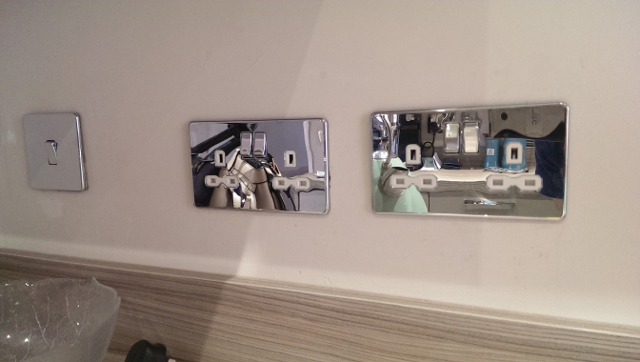
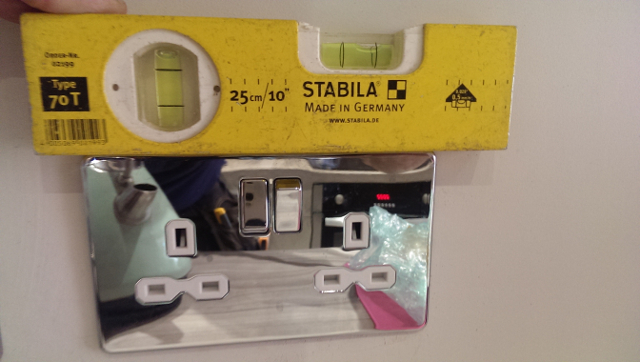


It’s this sloppy attention to detail and lack of forward planning during the dusty, dirty first fix stage which lets down the final appearance once everything has been plastered and painted. The homeowner told me she could see the boxes hadn’t been mounted level and claims to have queried it with the installer who assured her it would be sorted out on second fix. Of course, by second fix the boxes are plastered into the wall so it’s no small task to adjust them. If they are ever to be level, then the plaster will have to be chiselled out around them so they can be reseated, then made good with filler before repainting.
Speaking of plastering, what on earth is this...??

These cables haven’t been sunk deeply enough into the walls and someone has made a half-arsed effort to slap some filler over them like that’s going to make things better! A professional would have put in a deeper chase and capped the cables with steel or plastic to prevent them getting nicked by the plasterer’s trowel. This is a visible section of wall, not one hidden from view, and kitchen fittings have been placed below it so getting this made good now is going to be very tricky. The best bet is probably to cover it with a wide conduit painted to match the walls, but who wants to see conduit when the opportunity was there to bury the cables and achieve a flush finish?
The installer had fitted undercupboard LED strips, but only one of the three strips was operational. The clients told me the installer had spent 'a couple of hours’ trying to figure out the problem before blaming a bad LED driver. Inside of two minutes, I had placed a voltmeter on the output of the LED driver and confirmed 12V DC was present, then tracked down the bad connection to incorrectly fitted end-connectors on the strips. The clients were rather surprised to watch me bring the other two strips to life so soon after walking through the front door and with nothing but a voltmeter and my fingernail to prise the end-connector open with.

If the prior installer couldn’t diagnose a simple issue as quickly and easily, and if they did spend so long on it before misdiagnosing the fault completely, then just how competent can they be?
Besides bad workmanship, some of the accessories appeared cheap and nasty. I put a two year no-quibble warranty on anything I supply and install and I don’t want to lose time and money through warranty call-outs, so I only supply kit I trust. Here, a no-brand LED strip had been installed under the cupboards, and although I got all three working, one had a noticeable flicker and needed replacing.
While all of the above throws an interesting light on the poor quality of the installer, we’ve yet so see anything that flouts the wiring regulations, so here comes the juicy stuff.....
The clients had a 16th Edition consumer unit which was about twenty years old. Okay, the lighting circuits weren’t RCD protected, but the CU was in good condition overall and was complaint with the standards of its time. Although alterations were happening to the electrical installation including a new circuit to be installed for the oven, only those new alterations had to be compliant with today’s standards (17th Edition Amendment 3 at the time of writing); overall the old CU remained fit for purpose. I had told the clients in January that the CU didn’t need to be changed and could accommodate the alterations, but for whatever reason, these guys installed a new consumer unit.
That’s not necessarily a bad thing; at least all the circuits in the house are now RCD protected, however in my opinion it was an unnecessary expense which the clients were told was required after being fed duff information. Unfortunately, the upgrade has been done badly so the advantage of the additional protection afforded by hanging all circuits off RCD's is somewhat lost on the glaring regulatory non-compliances caused by the inattentive installation work.
Starting with this; the cable entries at the top of the CU. Regulation 416.2.2 requires the “horizontal top surface... of an enclosure... shall provide a degree of protection of at least IP4X”. To meet IP4X, a solid object 1mm or more in diameter should not be able to penetrate the enclosure. It's clear that the holes around these cables are far too large allowing dust, water leaks or foreign objects to enter the live consumer unit. Also there is missing edge strip around most of the sharp metal edges risking damage to the cable insulation.

With such wide holes, a fire starting in the enclosure has a source of oxygen and escape and I’m betting the main selling point for changing the CU was the line I so often hear about ‘plastic consumer units no longer being compliant’ as they cannot contain a fire. Bullshit. Non compliance ony applies to the installation of new enclosures. An existing properly installed plastic CU will contain a fire better than this well-ventilated metal box! Anyway, I won’t get into the lies about plastic consumer units here, there’s a whole other article on that subject.
Things don’t get any better on the underside of the CU. The tails and main earth should be entering the enclosure via a gland to provide strain relief and protection from the sharp metal edges, but that costs the same as a pint of Guinness, so I guess they figured they’d spend the money elsewhere....

Still, lack of strain relief on the tails isn’t likely to be a problem if the tails are secure, right?

Yes, you’re seeing that right; those tails are not clipped or cleated to anything. They’re not even run against the wall. This is in an under-stairs cupboard filled with bags, brooms and other such items which are one day likely to catch around the flapping tails, so a good yank may well result in the tail insulation being damaged by the sharp CU edges or, perhaps over time, a loose connection forming at a main terminal which can lead to arcing, thermal damage and eventually the risk of short circuit or fire. Regulation 522.8.11 states “cable supports and enclosures shall not have sharp edges liable to damage the wiring system”, and the flapping tails contravene Regulations 522.8.1 and 522.8.5. The strain on these tails is all on the connection points which goes against Regulation 526.6 and any movement will quickly loosen them.
Also, notice the lack of an external isolator. In order to kill the power so they could change the CU, they have cut the supplier's seal and pulled the main fuse.
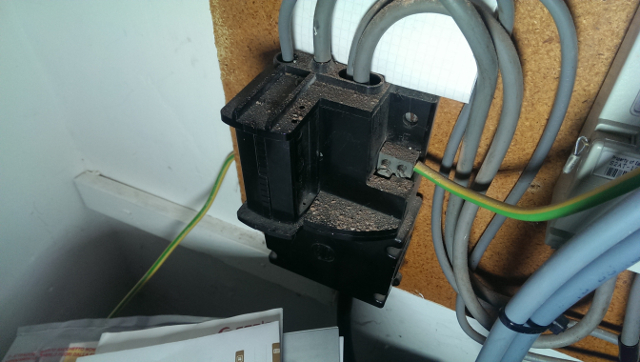
Naughty naughty, the seal and fuse belong to the network operator and jobbing electricians lack the authority to meddle with either, although show me a sparkie who claims to have never cut a fuse seal and I’ll show you a ruddy liar! That said, when I have to change a CU where there’s no isolator, I arrange for an authorised installer to fit one beforehand. Sure, it adds to the cost of the job, but my name is my reputation, and if a client isn’t prepared to pay to have the job done properly in the first place then I’m happy to stay in bed while they go to the competition. Unfortunately, the work we’re seeing here is what the competition in this case passes off as being of an acceptable standard.
There is an RCD notice affixed to the new CU, but there is no two-colours label as required by Regulation 514.14.1. Although only the older colours are in use within the consumer unit enclosure, newer wiring colours exist within the installation, including as just installed in the new kitchen by these very fellas.

This consumer unit would have been supplied with a two-colours label, so its omission, like other aspects of the work we’ll see here, is inexplicable. It may be a minor detail, but all they had to do was to slap on the sticker and Regulation 514.14.1 would have been complied with. It was that easy.
Although not technically a fault of the installer, one issue with some Hager brand consumer units is excessive exposed copper at the RCD terminals as shipped from the factory. Someone working on the board who has failed to follow safe isolation procedures is at risk of shock or short circuit if they make a slip. The installer should have modified these connections to eliminate the excessive exposed copper and removed the risk.
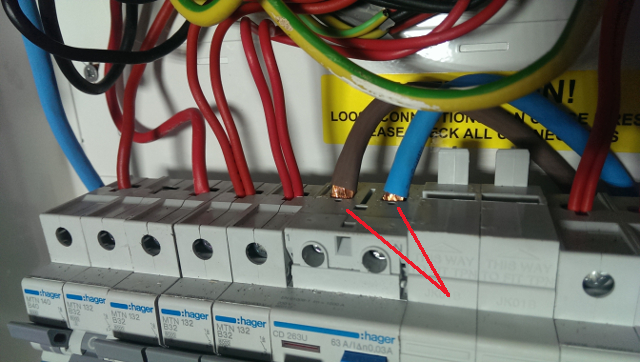
When contacted, Hager said it’s okay as the board should not be opened with the main switch on, however sometimes you need the board to be exposed and energised for diagnostic purposes. I know that if I were to terminate circuits into the breakers with that much copper visible, NICEIC would be pulling me up for it on my assessment visits. It certainly shouldn’t be one rule for me, another for the manufacturer. Regardless of Hager’s opinion that it is acceptable, as a purchaser of consumer unit equipment I can say definitively that I don’t like it. Other installers have been vocal on social media about this same issue, so I hope Hager start listening.
The correct procedure before replacing a consumer unit is to perform a full inspection and testing of the entire electrical installation that is dependent on it. This includes all the final circuits, not just those being modified, after all the installer is changing the protective devices for all the circuits so they ought to know what state those circuits are in before accepting that liability. A fully inspected and tested domestic installation can be signed off for up to ten years if in top condition, however only one year has been put on the label here. Why?

Without any certification or documentation regarding the installation we have no test results or comments on why these installers are not confident in letting more than twelve months pass before a total re-inspection is necessary. Considering the installation work already seen, and that still to come, I wouldn’t trust these installers opinion even if they do claim to have performed a full electrical inspection, and only by appointing someone accredited, qualified, insured and approved for such work can we be confident the installation is safe for continued use.
I don’t like the generic T&I labels like that shown above as they give little detail. They comply with Regulation 514.12.1, but don’t tell you much of use. My labels give the dates as required, but they also have my company name, accreditation information, contact details and the unique certificate/report number which relates to the inspection date shown.
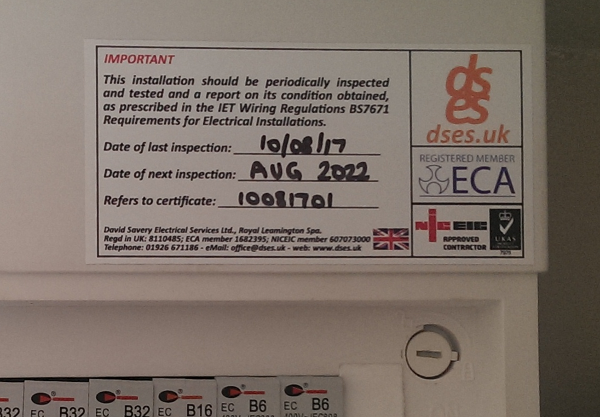
A label such as mine means any installer or new property owner can recognise who has performed electrical work, and by obtaining the cert it’ll show what that work was – new circuit, new CU or EICR. Even if the cert/report has been lost, a new copy can be requested from my files. It would be nice if the upcoming 18th Edition beefed up this kind of basic stuff, but that won’t happen because it sounds too much like common sense and the job of the IET is to sell expensive Regs books and increase the paperwork burden for installers who try to work legitimately. Let's hope the 18th Edition books lack the kind of errors seen in 2015 when the IET were caught snoozing and got their numbers wrong for disconnection times in the new yellow On Site Guide, forcing them to issue a hasty and embarrassing errata!
Moving on from the consumer unit, we’ll see some other basic, horrors that no electrician should be performing. Like these....


Above is an undercabinet lighting transformer and one of eight downlights showing the outer sheath not entering the cord grip and, in the case of the transformer, with the earth wires cut off in defiance of Regulation 411.3.1.1 so that the outgoing cable to the next transformer has no circuit protective conductor.
Regulation 526.6 states “There shall be no appreciable mechanical strain on the connections of conductors” while Regulation 526.8 requires “cores of sheathed cables from which the sheath has been removed... shall be enclosed”. To comply with both of these regulations, the outer sheath of a cable must enter an accessory enclosure and be captured in any strain relief mechanism. Here we can see where the grey outer sheath has been cut back before entry into the enclosure leaving the basic (brown/blue) insulation exposed.
Let’s take a closer look at one of those downlights...
 |
 |
The inner insulation is being damaged through crushing by the cord grip while incorrect termination at the terminal block has the screw going through the insulation. The latter can cause a high resistance joint which may eventually burn out. Dead testing and visual inspections will usually uncover such problems, but a lack of paperwork means there is no evidence that any testing has been undertaken on this installation. As is, this does not comply with Regulation 526.1.
Metal light switches have been installed without being earthed as required by Regulation 411.3.1.1, although technically they are earthed when screwed to the knockout box, but come on, an earth tail costs nothing. Also, switch drops have not been sleeved to identify their function (Regulation 514.3.1). This is basic stuff.

It was also observed that the centre switch in a three-gang plate had been connected upside down (L2 terminal instead of L1) which meant that light operated in the opposite way to the other two switches. This suggests a lack of basic care and attention.
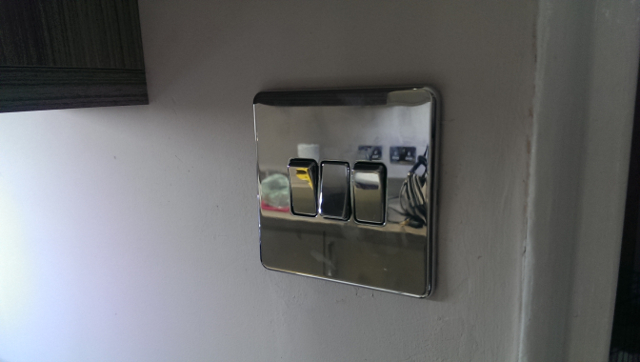
Not that the leftmost switch will ever do anything. It’s supposed to operate over-cupboard lighting, but instead of a line/neutral at the brown/blue wiring installed up there, only line/line is present. Obviously a miswire, but the junction has now been hidden somewhere, probably above the newly plastered and painted ceiling, so that isn’t going to get corrected without calling in a plasterer.
It is also the case that the boxes are clogged with plaster debris which can damage the wiring when the accessory is pushed into place, and that some boxes are not earthed. Although technically the boxes aren't required to be earthed if the accessory screws pass through at least one fixed lug, I prefer to view them as exposed conductive parts (Regulation 411.3.1.1) to mitigate against someone opening the accessory without isolating the power. Again, an earthing tail costs nothing.
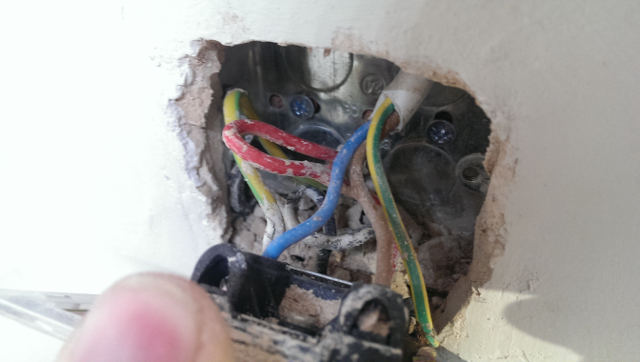
Another issue with the downlights was that the holes cut into the ceiling were too big for the diameter of the downlights they installed. This results in them sitting poorly, barely clinging onto the plasterboard. One downlight was also observed to have a dented bezel which can only have resulted from a drop impact either during carriage or on installation. The installer has proceeded with installation rather than replacing the dented unit.
Finally, one last picture to give you nightmares:

Regulations 522 and 528 requires a wiring system to not be installed where they may be subject to external influences or in the proximity of non-electrical services unless specific conditions are met on protection or spacing. This is not the case here where the central heating cabling is to be found draped over the copper pipework.
Okay, I know what you’re thinking. Maybe this is like Cowboy Competition #5 where an inexperienced kitchen fitter did the electrical work and found a no-questions-asked sparkie to sign it off? Well, no. This is the work of an outfit whose website claims them to be "fully qualified, Part-P certified electricians".
Part-P certified electricians? Certified by whom? A check of the Electrical Competent Persons database under their company name or postcode shows no hits, so they appear not to be accredited with any CPS scheme. The only way they can legitimately undertake Part-P work therefore is by directing the homeowner to submit a planning notification to Local Authority Building Control before they start the work. That’s an expensive business, but the client here hasn’t been handed any instructions or paperwork prior to work commencing, and despite requests from the client for the electrical installation certificate and building regulations compliance certificate for the consumer unit change, neither have been forthcoming. And what does "Part-P Certified" even mean? Part-P is a building regulation, not a qualification as I’ve covered before. You can work to within the requirements of Part-P, but nobody has a framed certificate hanging on their wall to say they are ‘Part-P qualified or certified’, or if they do then some fly-by-night training provider has stiffed them on a bullshit electrical course. These boys don't seem to know of their responibilities under Part-P: they’re unable to self-certify the work through a CPS, they haven’t provided any evidence of lodging a planning application before starting this job and they’ve provided no certificate of compliance for the work they've completed. They appear to have failed here, in every way, to abide by the legal requirements of Part-P, regardless of what qualifications or certifications they think they have for this specific work.
Still, at least they’re not pretending to be affiliated with a CPS. Their website and advertising lacks any logos for NICEIC, NAPIT, Elecsa, Stroma or any other government approved CPS scheme. Many rogue electrical installers pretend to have such affiliation in their false advertising. Even so, the trouble here is that if their website and advertising suggests they are aware of their responsibilities under Part-P, then that may have led the builder/homeowner to believe they would be supplied with the legal paperwork for the job. Under Consumer Protection from Unfair Trading Regulations (2008) legislation, a trader cannot undertake misleading action by deceiving clients to the nature of the goods or services they’re expecting to receive which may lead them into deciding how to proceed. Had the client been aware at the selection stage of the fact they would not receive their statutory certification for the work, then they may have made a different choice of contractor.
Personally, I only offer domestic or commercial work as industrial electrics scares the piss out of me. Imagine working with high voltages, heavy three-phase machinery, monster SWA cables and the like! And yet, I have decent electrical qualifications, NICEIC Approved Contractor status and ECA membership. I’m not claiming to be any kind of sparkie Superman, just that I know where my limitations and comfort zone lie, so the fact these fellows also offer industrial services on their website when the standard of their domestic work is this bad really is beyond me.
Interestingly enough, despite the lack of CPS accreditation and with work of this standard, there are a couple of places where this outfit appear online as being ‘approved’. I’ve talked before about these trade directories who claim to vet their members and provide tradespeople "you can rely on", well you can find these boys on Rated People, and also, disappointingly, the QuickFind directory which claims to carefully select and vet their 'trusted and approved' advertisers.
The adverts for these chaps show no accreditation logos. QuickFind say that they check advertisers claiming trade association membership really have such, but if you’re not claiming to be a member of a trade association and you’re operating outside of such framework, then it kind of falls on its arse, and in this case the client is left without a legitimate CPS channel to make a complaint through. At the time of writing there are no customer reviews for these lads on either Quickfind or Rated People and this is the problem I have with these directory services who throw around words like 'approved, trusted, vetted and rated' as most of them only perform simple checks that their advertiers are solvent, have basic insurance and are valid members of any associations they claim to be members of, after that they're released to the unsuspecting public as being valid, vetted and trustworthy. It's only when clients have been screwed over will negative reviews start rolling in to warn off others, although poor reviews are often squashed as they're bad for business. Even if they do get through, by then the damage has been done and people are out of pocket.
So, the clients asked me to compile a report that they may use for furthering any complaint, and to make good as I went along.
Spoiler alert: plot twist approaching!
Many of the issues were quickly resolved, the faulty LED strip, the poor terminations, the heating wiring, the incorrect switching, missing accessories and.....
...and then I turned up this week to receive a bollocking from the client. Remember I said one downlight had a dented bezel? Well, they chewed me out for being responsible.
Not in a nice way you understand. Not in an inquiring “I didn’t notice it like that before” probing kind of way. Literally an “I’m not arguing with you:- you did that” accusation. Shocked? Why, I almost splilled my Pimms & lemonade!
You know, accidents happen. When swinging tools around on site, sometimes things get bashed or knocked, but I’ve always owned up to it. I figure sooner or later the client will notice, so it's best to put your hands up and maintain the integrity of your reputation. Small examples are mud trodden into a newly cleaned carpet, cracking the LCD screen on a smart meter monitor, and cracking a new light fitting (that’s happened twice). The worst example was working in a kitchen and scratching the glass on a new halogen hob, but in all cases I’ve come clean with the client, and where they have asked me to make good I’ve done so without argument at my own expense.
It’s just good reputation-enhancing business practice and I take it as a learning experience. These days, I ensure a glass hob is covered before working near one, I check delicate items for damage before starting work to ensure I won’t be accused of causing it afterwards, and I try to be especially careful with those horrible ceramic wall lights which can break if you twist the screws a little too tightly!
So, the accusation I was presented with somewhat grated with me on this one. As mentioned, the downlight could only have been damaged in carriage or on installation by dropping onto a hard surface, and although we had re-terminated it properly, we hadn’t dropped it. If we had, I’d have fitted another downlight. Nothing would have been easier; these are low-cost models and there’s an array of electrical distributors within five minutes’ drive of site, so there was no reason to try and conceal anything. It was easily resolvable, same-day and at the equivalent cost of a couple of cups o' coffee.
Personally, I believe the client just didn’t notice the dented bezel before, but when we re-terminated it we perhaps placed it back in the ceiling at a different orientation which made it more obvious from certain vantage points. I offered that view, but was shot down.
This is why, should this situation arise again, I will be unwilling to come to undertake any remedial work without first being paid to perform a full inspection and audit of all that is wrong. Call this another learning experience under the belt. I guess it doesn’t matter how old you are, there’s always something new to surprise you occasionally.
As a goodwill gesture, I did replace the dinked downlight, but I’ve had to inform the clients that I cannot undertake any further work for them. We know there are all sorts of iffy issues the previous installer left us with and I can’t run the risk of being blamed for something else they hadn’t noticed before. The precedent is set, so now they’ll have to find someone else to tick any outstanding items off the list.
It’s a shame, but had they accepted my quote in January, they’d be in a working kitchen today with level accessories, operational lighting and all the paperwork sewn up. I like to think my price was competitive, so just how much cheaper were these guys, especially seeing as they changed the CU which I didn’t believe was necessary?
If they truly came in under my price, and by enough to tempt the client to plump for them instead of using me as a trusted installer whom they had employed in the past, then I guess you get what you pay for, but it goes to show that you should always choose your installer based on more than just the monetary figure written on the quote. If I cost more, it's because I have multiple avenues of consumer protection built in to the service I provide. NICEIC, ECA, Which? and TrustMark are all independent bodies a dissatisfied client of mine could escalate a complaint to, if indeed they felt they had cause to complain about the service I provided, but to maintain my reputation I would try to ensure it never came to that. It's that value-added peace of mind which necessarily costs extra, and forking out for that at the start of a project makes more sense than going for a cheaper guy who ends up botching the job.
Update 29/10/17
While out and about this morning I spotted their van now sporting a NAPIT logo. It seems these lads have now managed to get themselves accredited.



